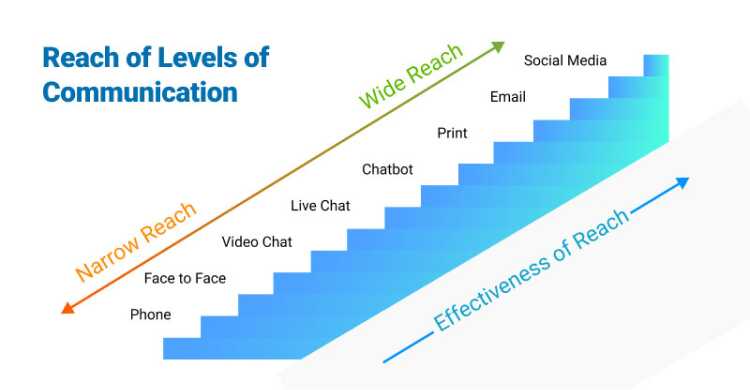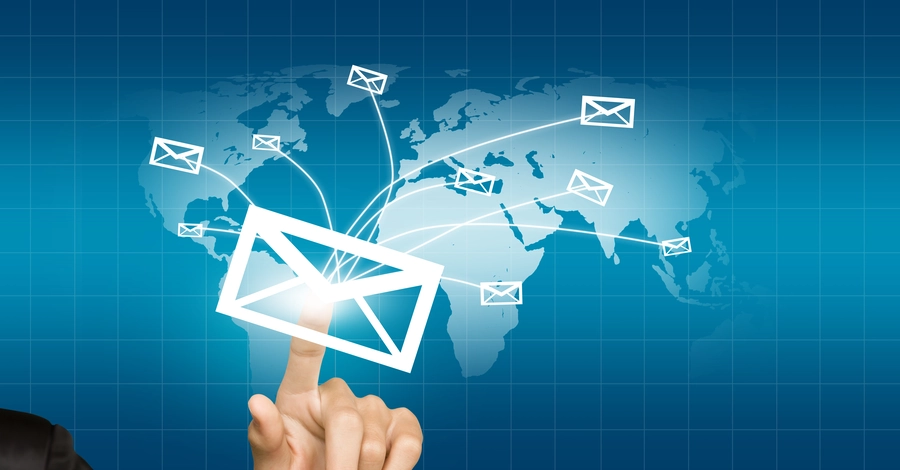Top Customer Communication Channels for Businesses
- May 5, 2021
- 12 mins read
- Listen

Table of Content
Communication channels play a big role in helping brands and customers connect with each other for various forms of engagement and interactions.
Businesses that have mastered the art of communicating across various channels can easily provide a seamless experience to customers who generally vary by behavior and demographics.
In fact, brands achieve 91% greater customer retention when they implement omni channel strategy.
Having multiple customer communication channels for engagement and interaction is, therefore, the need of modern times to boost the level of customer experience.
The focus should therefore be on letting customers smoothly switch between channels as this can prevent any breakdown of communication and help companies realize the customer engagement goals.
In order to achieve omni channel communication, it is important to first understand your customer expectations and then identify the right channels. The below image shows the level of different communication channels.
What are customer communication channels anyway?
By definition, customer communication channels are the medium by which businesses communicate or interact with customers. Some examples of customer communication channels include phone, email, social media, etc.
There are basically two types of channels, i.e. traditional and digital communication channels. While traditional channels continue to exist and used for decades, digital channels are relatively new and have emerged in the last 20 years or so.
The type of channels to select depends on the nature of messages and also depends on customer expectations. In general, businesses use both types of communication channels to meet the expectations, geographies, and demographics of customers.
How to select the right communication channels
86% of buyers will pay more for a great customer experience.
Great customer experience however is always built on the foundation of prompt and effective communication.
The very first thing for the business is to identify the right customer contact channels before looking to achieve effective communication whether for sales, marketing, or customer support.
Three key parameters need consideration to select the right channels:
- Identify your customer expectations – Understanding what your customers want, how they want it, and where to communicate with them in the most efficient manner is crucial to plan your communication strategy.
- Consider your message – The kind of messages your business wants to send, whether formal or informal, time-bound or trivial, needs to be considered in selecting the right communication channels.
- Take into account your budget – A business has to decide how far it wants to go in terms of budget as choosing multiple channels for communication will definitely cost more than staying selective in approach.
Types of communication channels and how to use them
Marketing communication channels abound today, so businesses are certainly in the right position to gauge the trend of client interaction better.
In fact, 10% year-on-year growth can be achieved by brands that invest in omni channel engagement strategies.
So rather than choosing all customer support channels, it’s more important to look to bridge the gap between what new-age customers expect today and which platform can help deliver effective communication. Here a quick tap to the popular communication channels both traditional and digital.
Let’s understand the types of communication channels available for brands and the way to use them effectively for superior customer care:
Website
Website channels such as live chat, video chat, and chatbots are extremely popular today among customers to contact businesses. A growing number of brands are using them to deliver quick and personal service to website visitors and help drive conversion rate.
1. Live chat
Live chat has become an extremely popular business communication platform as it’s not only trendy but also ensures quick responses.
After all, 38% of customers are likely to buy more if your company offers live chat as a form of communication.
- Live chat can work as a 24×7 support channel and conversations can take place anytime and anywhere.
- Quick and tailored responses can be offered to customers on the website journey.
- Agents can use live chat software to take customers through the website and boost the experience.
- The conversations started via live chat may progress to the next level, i.e. to video or voice call, if customers are satisfied with the response.
2. Video chat
Video chat is easily among the most preferred customer experience communication channels purely for enabling highly personalized service.
You have to believe it because more than 8 out of ten corporate businesses use video chats.
- Brands can use video chats to deliver an in-person experience on the web and ensure a visual perspective to customers.
- Video chat is also a very useful customer service channel for showing things and solving complex problems that chat channels can’t handle.
- By using video chat, agents can deliver a remote-basis and real-time in-person support via sharing screen.
3. Chatbot
Chatbots are fast becoming an integral part of the customer support strategies of businesses of all sizes and from all industries.
So much so, they are currently handling nearly one in six customer interactions globally.
- Chatbots can work 2×7 and simultaneously enable quick responses to multiple queries.
- Using chatbots together with human touch can greatly enhance the efficiency of customer support.
- Brands are using chatbots to answer the most common questions of customers and also employing bots together with human responses for complex queries.
Messaging
Messaging as a channel of communication has the reach, acceptance, and high open rates which brands find useful.
Even customers are not behind as, more than 6 out of ten believe that brands should use messaging more often to communicate with customers.
The use of messaging is also growing not only for customer support but also in marketing, sales, and information dissemination.
4. Social media
57% of consumers follow a brand on social media to know about new products or to stay up-to-date on company-related information.
Social media platforms have gained a reputation for being a great channel of communication as customers today prefer to find businesses there.
Companies can leverage the huge user base and reach of social media for meeting marketing, sales, customer support targets easily.
- The use of use media can prove extremely effective in establishing engagement with both existing and new users early in the customer journey.
- Social media can be used not only as a powerful contact channel but also as an effective marketing tool for realizing business goals.
- Different geographies and demographics can be catered easily using social media ads and this can help achieve marketing goals.
5. Messaging apps
The ever-growing popularity of messaging apps is a clear indicator of the changing trends on the front of communication.
Nine out of 10 people with smartphones access messaging apps which shows where is the future of customer communication lies.
The apps like WhatsApp, Facebook Messenger, Viber, Telegram have added a new meaning to communication for users, and also between companies and users.
- Messaging apps are more in alignment with the modern-day habits of users and can be a perfect tool for marketing, after-sales, and customer support purposes.
- Brands are using consumer messaging apps to engage customers with messages of offers and promotions.
- As a proactive channel, messaging apps prove helpful in getting better follow-ups than reactive channels like email and phone.
Email continues to be a top-3 distribution channel for both B2B and B2C marketers.
For brands, email has always been a reliable form of communication with customers. It’s a cost-effective way to reach the target audience and maintain ever-going relationships.
Companies can rely on email for formal communication in cases where immediate response is not needed. Whether to share information or correspond with the customer base, the value and cost-effectiveness that email provides are hard to match.
- Email is a versatile communication channel and can be used for purposes such as marketing, news sharing, personal correspondence, etc.
- Companies can use email to offer a personalized experience and show they value customers.
- Messages can be adjusted to suit different audiences and personalized content can be shared with a vast customer base quickly to build trust.
Face to Face Communication
Face to face communication has a big value for building trust and transparency with customers. Important deals and key decisions are always made by meeting with clients in person. Businesses can make $12.50 for every dollar invested in face-to-face meetings.
Such communications are considered vital in enhancing productivity by the exchange of information and ideas in a quick manner.
6. One to one meetings
Nothing can come close to speaking to your customers in person.
Companies all over the world understand the great value that one-to-one meetings offer so they make it a key component of a great customer engagement strategy.
Whether conducted digitally or in-store, such meetings can help build confidence in customer/s and ensure all their doubts are solved.
- One to one meetings are great for delivering a super-personalized experience to customers.
- Using such types of meetings can help build a reputation as customers can talk to brands in person and find solutions to problems.
- Companies can better understand not only the message but also the body language, gestures, and facial expressions of customers with this form of meeting.
7. Video Conferencing
Video conferencing tools can help companies save from 15%-30% of the total project cost and also shorten project timelines.
Video conferencing as a communication channel has helped businesses build strong client relationships without spending big on time and money. It can help boost the capacity of the sales and marketing team and ensure faster closing of deals.
- Brands can use video conferencing to build a strong rapport with customers by having a good understanding of body language and tone of voice.
- Geographical restrictions and time-zone issues can be successfully negotiated when video conferencing is used for client communication.
- Screen sharing can enable live product demonstration, walkthroughs, and also sharing of presentations and marketing collaterals as a sales pitch.
Phone
Phone as a channel of communication is here to stay forever, no matter how much other channels evolve or grow in popularity.
In fact, phone calls have forever been an excellent communication channel to discuss important/urgent issues with customers and deliver prompt responses.
Companies of all sizes rely on phone support for a diverse range of communication, such as marketing, sales, information sharing, and customer support.
- Phone can be used for business communication in cases where visuals are not necessary to share or exchange with customers.
- The use of voice messages adds more value to phone calls as customers don’t need to wait for an immediate response from the other side and can leave the message for later use.
- The customer service team can help provide the right support and build engagement through a call-based contact center.
Community
A community can work as one of the unique types of communication channels as it gives brands an opportunity to broadcast messages, share news and disseminate information with a wide audience base.
Platforms such as Facebook & LinkedIn groups are great for building userbase and doing customer engagement while active participation in forums can help share knowledge with customers.
8. Groups
Brands benefit a lot from social media groups as it provides them an opportunity to connect with a big group of people with similar interests and behaviors.
There has been a sharp rise in the use of groups such as LinkedIn and Facebook groups for engagement, marketing, and knowledge-sharing purposes.
- Companies can use social groups to gather useful audience insights and understand a lot about the target audience through their conversations.
- Social groups are a great way to engage with customers either through direct or one-on-one way communications and build trust.
- Open communications on groups can prove helpful in building relationships and trust with the audience.
9. Forums
Forums are one of great customer communication channels to encourage discussions and connect over shared experiences.
- Brands can join the topics relevant to the industry and add more meaning to active engagement with the target audience.
- Online forums can become a key part of a communication plan to contribute to ongoing conversations or drive the flow of communication with users.
- Customers can share their views, suggest ideas, and recommend solutions on forums which companies can use to improve communication and engagement.
Traditional Channels
Brands continue to leverage the vast reach of traditional media for marketing, news, and information sharing purposes.
Channels such as TV, Radio, newspapers, and Magazines are still revered a lot for a widespread yet targeted reach.
10. Print
Print is an affordable medium to advertise and spread awareness among a vast group of audience. Brands use print media sources such as newspapers, magazines, catalogs, and leaflets to grab the reader’s attention and deliver the message.
- Print enables a higher frequency of viewing which means the message can be viewed over and again for a long period of time.
- Brands can have a great deal of control over the appearance and decide aspects like design, color, style, font, topography to present messages in an effective way.
11. Broadcast ( TV & Radio)
Broadcast media channels such as TV and Radio are easily the most powerful tool for marketing businesses across a vast audience.
- Using the broadcast channels, it’s possible to gain a very high mass audience coverage and build a solid trust for business.
- High frequency and quick delivery of messages is possible with TV and radio.
- Television and radio are also the most trusted sources of customer experience communication channels and the messages delivered over them have high value and impact.
Drive customer experiences through right digital communication channels
Communication channels always have been indispensable to businesses in delivering messages to customers and achieving goals on the front of marketing, sales, and support. Using them sensibly can boost the level of customer communication and also ensure value to both the parties, i.e. brands and customers.
It’s therefore important for businesses to devise the right communication channel strategy with a focus on syncing up all the customer touchpoints. When that happens, an omni channel communication strategy comes into effect in true sense.




